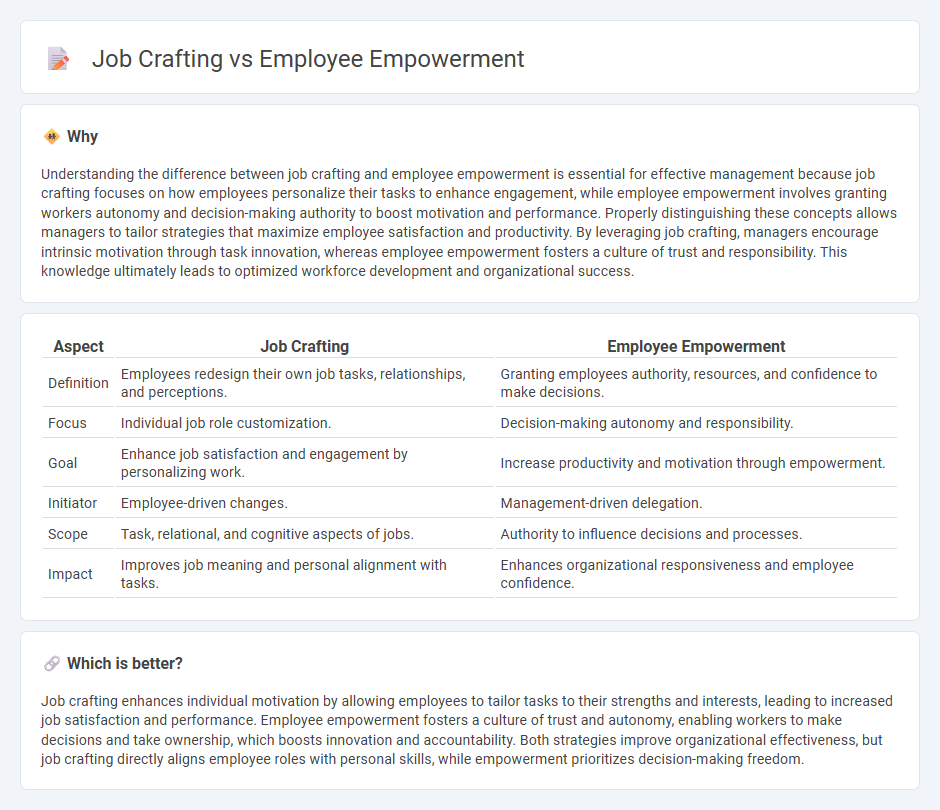
Job crafting allows employees to redesign their tasks and interactions to better align with their strengths and interests, enhancing job satisfaction and performance. Employee empowerment grants individuals autonomy and authority to make decisions, fostering a sense of ownership and increased motivation. Explore how integrating both approaches can transform workplace dynamics and drive organizational success.
Why it is important
Understanding the difference between job crafting and employee empowerment is essential for effective management because job crafting focuses on how employees personalize their tasks to enhance engagement, while employee empowerment involves granting workers autonomy and decision-making authority to boost motivation and performance. Properly distinguishing these concepts allows managers to tailor strategies that maximize employee satisfaction and productivity. By leveraging job crafting, managers encourage intrinsic motivation through task innovation, whereas employee empowerment fosters a culture of trust and responsibility. This knowledge ultimately leads to optimized workforce development and organizational success.
Comparison Table
| Aspect | Job Crafting | Employee Empowerment |
|---|---|---|
| Definition | Employees redesign their own job tasks, relationships, and perceptions. | Granting employees authority, resources, and confidence to make decisions. |
| Focus | Individual job role customization. | Decision-making autonomy and responsibility. |
| Goal | Enhance job satisfaction and engagement by personalizing work. | Increase productivity and motivation through empowerment. |
| Initiator | Employee-driven changes. | Management-driven delegation. |
| Scope | Task, relational, and cognitive aspects of jobs. | Authority to influence decisions and processes. |
| Impact | Improves job meaning and personal alignment with tasks. | Enhances organizational responsiveness and employee confidence. |
Which is better?
Job crafting enhances individual motivation by allowing employees to tailor tasks to their strengths and interests, leading to increased job satisfaction and performance. Employee empowerment fosters a culture of trust and autonomy, enabling workers to make decisions and take ownership, which boosts innovation and accountability. Both strategies improve organizational effectiveness, but job crafting directly aligns employee roles with personal skills, while empowerment prioritizes decision-making freedom.
Connection
Job crafting enhances employee empowerment by enabling individuals to redesign their tasks, relationships, and perceptions at work, which fosters greater autonomy and engagement. Empowered employees who actively shape their roles contribute to improved job satisfaction and organizational performance. This dynamic interplay strengthens commitment and drives innovation within management practices.
Key Terms
Autonomy
Employee empowerment enhances autonomy by granting workers decision-making authority and control over their tasks, fostering intrinsic motivation and job satisfaction. Job crafting allows employees to reshape their job roles, tasks, and relationships, increasing their sense of autonomy through personalized work experiences. Explore how these strategies differ in promoting autonomy and impacting workplace performance.
Task redesign
Employee empowerment enhances task redesign by granting workers autonomy to make decisions, fostering innovation and personal investment in their roles. Job crafting involves employees proactively altering job tasks, relationships, and perceptions to better fit their strengths and interests, which can lead to improved motivation and performance. Explore our detailed analysis to understand how these approaches uniquely impact task redesign and organizational outcomes.
Engagement
Employee empowerment enhances engagement by granting workers autonomy and decision-making authority, fostering a sense of ownership and motivation. Job crafting increases engagement by allowing employees to proactively redesign their tasks, relationships, and perceptions to better align with their strengths and interests. Explore how combining both approaches can drive deeper employee engagement and organizational performance.
Source and External Links
Employee Empowerment: Benefits and Strategies - This webpage discusses strategies for empowering employees, including feedback, recognition, and opportunities for growth.
Examples of Employee Empowerment at Work - This article highlights examples of employee empowerment, such as involving employees in decision-making and focusing on recognition and rewards.
What is Employee Empowerment and How to Build an Empowered Team - This resource explains the concept of employee empowerment and how HR can foster it through training, open communication, and inclusive decision-making processes.
 dowidth.com
dowidth.com